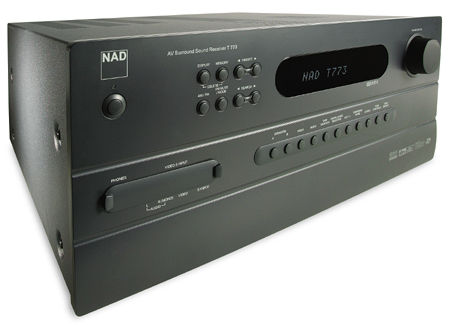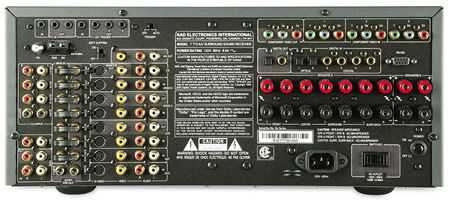NAD T 773 AV receiver

Now a division of Lenbrook Industries, NAD continues the tradition of high value with its line of home theater products. I spent a couple of pleasant months with this year's flagship receiver, the T 773, where it saw extensive duty, first in my small-room system with a Panasonic plasma screen and NHT speaker system, and second (briefly) in my large-room system, where it substituted for the Parasound Halo combo of C 2 preamp-processor and A 51 power amp. The NAD proved its worth in both cases.
Look and Features
Not the most glamorous piece of hardware that's graced the pages of Stereophile Ultimate AV, the T 773 is your basic big box, approximately the size of a beefy power amp, finished in charcoal gray with discreet white lettering. Horizontal grooves divide the front panel into three sections: the top with power switch, tuner buttons, and fluorescent alphanumeric display, and to the right of that a large volume knob. The midsection sports all the unit's function buttons, and a pop-off cover for the Video 6 inputs (S-video, composite video, and 2-channel audio), a convenience for camcorder users. Tone controls can be engaged or disengaged with the two buttons farthest to the right; once engaged, the volume control becomes a temporary treble or bass control. The bottom third of the front panel is clean, except for a row of logos indicating all the technologies incorporated within. The overall look is unpretentious and unimposing, with everything logically arranged for easy use.

Neatly arrayed on the rear panel are full complements of inputs and outputs, including seven channels of pre-out/main-in connectors joined by jumpers. There's also an IEC power connector for a detachable power cord, a switched two-prong convenience AC outlet, and the T 773's master power switch. There are nine pairs of closely spaced 2-way binding posts for all seven channels of amplification, plus an extra stereo pair for the Speaker B function. These terminals accept banana plugs, or you can screw them down securely on bare wire. Expandable, lock-in-place banana plugs are strongly recommended if the T 773 is to be installed where its rear panel won't be fully accessible.
Many of the RCA connectors on the rear panel are spaced only half an inch apart from center to center, making the use of large, audiophile-approved RCA plugs a bit problematic, but these are not the sort of cables likely to be used by most owners. I used Acoustic Research Performance Series cables in the small system with no difficulty.
The top left of the rear panel houses the IR and 12V trigger jacks. NAD has thoughtfully included extra outputs for both, making the task of plugging the T 773 into a custom installation all the easier.
The 52-pound T 773 is compactly built inside, with two hefty toroidal transformers stacked just behind the power connector. Two closely spaced heatsinks divide the left and right sides, and five small fans in a row directly beneath the heatsinks keep the NAD running cool no matter how hard you push it. The fans also serve to keep the heatsink weight and area—and, thus, the entire component's size—to a manageable level. I never noticed any fan noise in my two months with the receiver.
Soft Clipping
The back panel also includes a Soft Clipping switch. A proprietary NAD technology, Soft Clipping rounds out the hard edges of an amplified waveform as the amp is driven to the limits of its "rails," or absolute negative and positive power-supply voltages.
The effect, clearly visible on a 'scope on a test bench, can not only save speakers from destruction, but also make low-powered amplifiers sound much more robust than their specifications would indicate. The onset of harsh distortion is the audible cue that an amplifier is running out of breath; eliminating it is a brilliant way of mimicking the performance of much more powerful amps without the weight and expense. The benefits of Soft Clipping far outweigh any (mostly theoretical) liabilities, especially in a home theater system, where you're likely to encounter huge dynamic peaks from unexpected sound effects. I kept Soft Clipping engaged during my test drive of the NAD T 773. [The measurements, however, were made with soft clipping off (see sidebar)—TJN.]
Installation and Use
For most of the review period, I used the NAD with a Panasonic TH-42PWD3 42-inch plasma display, a Sony DVP-NS725P DVD/CD player, and an NHT speaker system. The Sony player was hooked up via component video and coaxial digital audio; a pair of cables also ran from the Sony's stereo analog output jacks to the NAD's CD input. Also, for comparison's sake, I ran an S-video cable from the Sony to an input on the plasma screen.
I also briefly tried running the output of an old Mitsubishi VCR into a composite video jack to see if the NAD would translate that feed into an S-video output. It did, although I could see no obvious benefit. The image on the plasma screen looked just as bad running the Mitsubishi's composite output directly into the plasma screen as it did converted to S-video through the NAD.
There is no corresponding upconversion from the S-video or composite-video inputs to the NAD's component-video output. To get component out, you have to give it a component in. As has been true with all the home theater gear I've tried, I could see no difference between the video image fed directly to the screen from the DVD player's component outputs or looped through the NAD.
However, there was a huge difference between the image generated by the S-video and component-video feeds. Although perfectly watchable by ordinary standards, the S-video image, viewed through the NAD, was soft, with washed-out colors and compromised contrast. The component image was sharp and vivid, with rich colors, bright in the highlights and dark in the shadows. It's a difference any novice could see without coaching.
The NAD setup is performed either through on-screen menus or the front panel display. It doesn't provide for automated calibration of speaker distance or level. For that, you measure the distance from your seat to each speaker and enter it using the setup menu. Each speaker can be set to Large or Small, according to its low-frequency capabilities, and the initial levels are set using the NAD's internal test signal and an SPL meter. (The RadioShack analog meter is ideal.) Once their levels are matched and entered in the NAD's memory, you shouldn't have to change them unless you change speakers or rearrange your room.
- Log in or register to post comments




































































